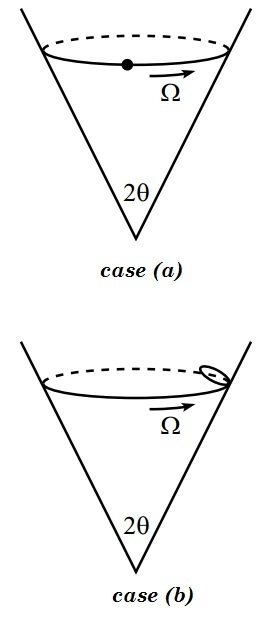Rolling in a cone
 (a) A fixed cone stands on its tip, with its axis in the vertical direction. The
half-angle at the vertex is
. A particle of negligible size slides on the
inside frictionless surface of the cone (see case(a)).
Assume conditions have been set up so that the particle moves in a circle
at height
above the tip.
(a) A fixed cone stands on its tip, with its axis in the vertical direction. The
half-angle at the vertex is
. A particle of negligible size slides on the
inside frictionless surface of the cone (see case(a)).
Assume conditions have been set up so that the particle moves in a circle
at height
above the tip.
Let the frequency of this circular motion be
.
(b) Assume now that the surface has friction, and a small ring of radius rolls without slipping on the surface. Assume conditions have been set up so that (1) the point of contact between the ring and the cone moves in a circle at height above the tip, and (2) the plane of the ring is at all times perpendicular to the line joining the point of contact and the tip of the cone (see case(b)). You may work in the approximation where is much less than the radius of the circular motion, . Let the frequency of this circular motion be .
Question: Find .
The answer is 1.41.
This section requires Javascript.
You are seeing this because something didn't load right. We suggest you, (a) try
refreshing the page, (b) enabling javascript if it is disabled on your browser and,
finally, (c)
loading the
non-javascript version of this page
. We're sorry about the hassle.
0 solutions
No explanations have been posted yet. Check back later!